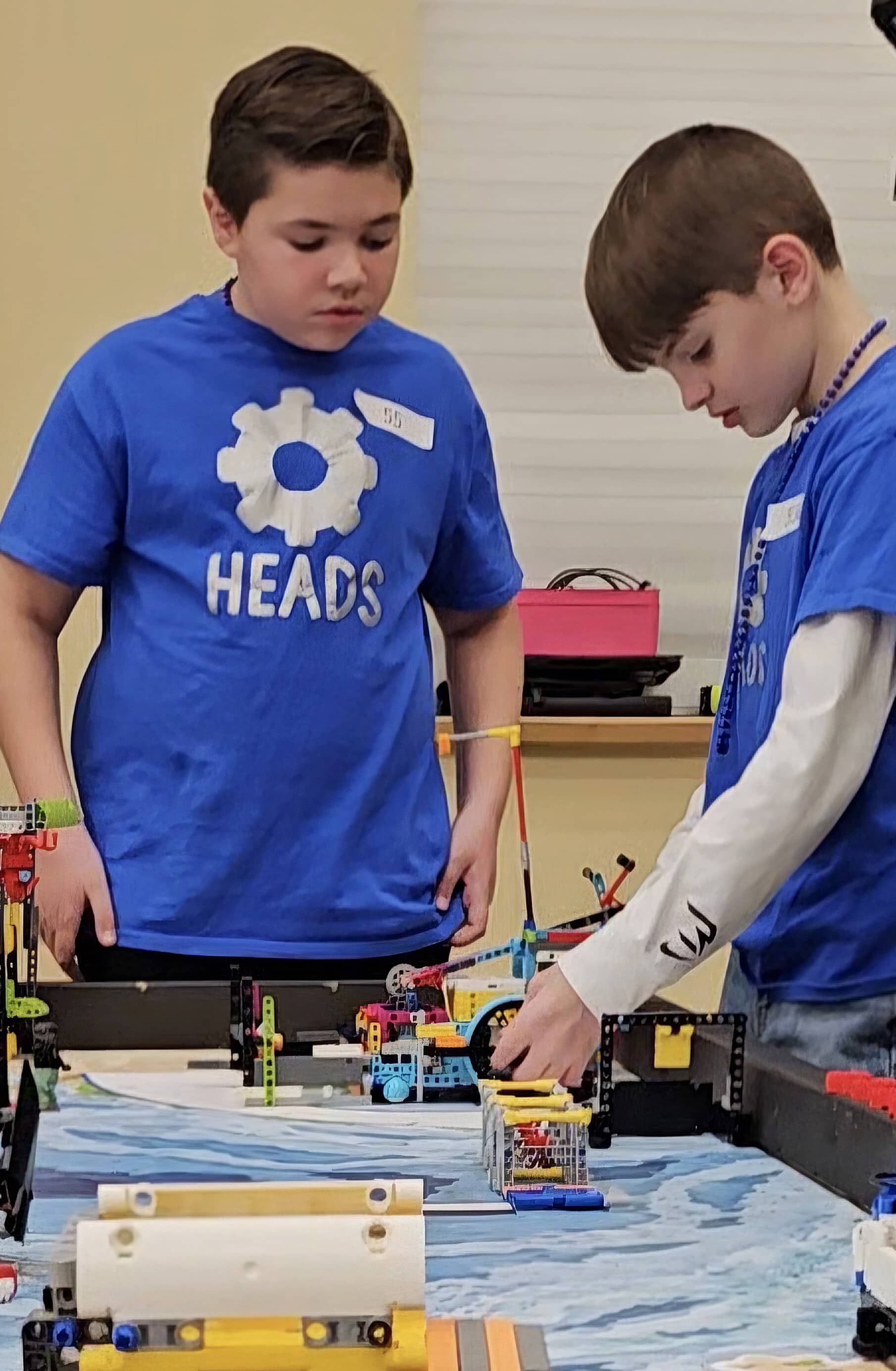Jake Terramagra (left) assists Liam Gleason in lining up a robot for launch at a state robotics championship competition. They are members of the Gear Heads, a First Lego League team in Agawam that built a small deep-sea mining robot.
Reminder Publishing submitted photo
AGAWAM — Using creative thinking and Lego technology, an Agawam robotics team engaged in research, problem-solving, coding and engineering to design and build a small robot to explore the layers of the ocean.
Doering Middle School students Calvin Johnson and Jake Terramagra, along with Hampden Charter School of Science students Liam Gleason and Fatih Cogal are members of the Gear Heads, a First Lego League, or FLL, team. The team is in the Challenge division, which is for youngsters ages 9-16.
Youngsters learn the basics of STEM and apply their skills in competition while building habits of learning, confidence and teamwork skills by working on a different FLL theme each season. For this past season, the theme was “Submerged,” where teams developed robots that could provide innovative — and real-world — solutions to help protect and preserve marine environments.
Head coach Frank Terramagra presented the team with some ocean related problems. The team decided to find a solution for the deep-sea mining of nodules — metallic lumps of manganese, iron and other metals — found on the ocean floor. “Our challenge was to dive into a problem faced by people who explore the oceans and come up with a project spark to solve this problem,” said Crystal Garner, the team’s assistant coach.
The Gear Heads researched deep sea mining by going to the library to learn why nodules are important, what the ecological impact is of mining, what the current mining looks like, as well as the pros and cons of sound underwater and more. Their mission was to create a way to mine the deep sea responsibly with less disturbance to the ecosystems and sea life.
To accomplish their mission, the Gear Heads — meeting two nights a week — designed and built a Lego robot that was programmed to complete the mission. The team used a Lego Education SPIKE app that included a series of coding experiences that progress from icon- and word-block coding based on Word Blocks to text-based coding based on Python. They also used the My Blocks app to write organized programs.
Robots can’t be more than 12 inches high and must fit in the launch area — approximately 12 inches by 12 inches — and must be made using SPIKE Prime Legos. “Our robot — which is approximately 8 inches by 10 inches — has four wheels, with a motor for each wheel. Motors are run by a rechargeable battery connected to SPIKE. It also has various attachments used in competitions,” said Garner.
The team’s deep-sea mining robot — the Dolphin Diver — has vacuum collection tubes to suck up nodules and uses thermal and visual sensors to detect animals. If an animal is sensed, the tube shuts off. There is also a “Noisy Air Fryer 2.0” that’s shaped like a ball and is suspended in front of the vacuum tubes. It produces sound waves and puffs of air to scare away animals so they won’t get sucked in.
The robot also has a filtration system so that anything two inches or smaller falls back to the ocean floor. Should any animals get in, two escape holes allow them to swim out. A collection tube sends the nodules up to a vessel above. The team also determined that mining should only be done in areas with the most nodules and the fewest number of animals.
Once the robot was completed it was time for some friendly competition among teams. Robots are judged in four categories: robot design, robot game, innovation project, and FIRST core values — discovery, innovation, impact, inclusion, teamwork and fun.
“Teams bring their robots with all of its attachments and their code, either on a laptop or printed out. Judges spend 30 minutes judging each category, asking teams questions about how they solved the robot game missions,” said Garner.
Each mission is worth points and the team has two and a half minutes to complete as many missions as they can. Teams compete in five matches with the highest score being used for awards.
The team’s creative skills and hard work earned them a “golden ticket” to participate in the Massachusetts FLL States West Championship in Worcester this past December. The team was formed during the 2022-23 school year, but this was their first trip to the state championship. They were among 72 teams that competed. The top teams from this competition advanced to the FLL World Festival.
“We had one week to prepare for the state competition, during which we met a few times to review feedback from the judges, improve our presentation and improve coding for our robot,” shared Garner. While the team didn’t qualify for the FLL World Festival, Garner said they learned a lot more about the program and their team from this experience.
Johnson summed it up this way: “Lego League was really fun and it was super exciting to go to state championship. It was great to represent Agawam.”


